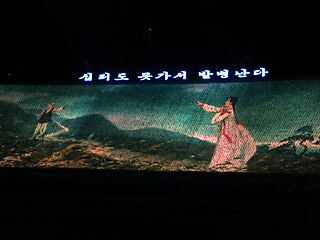 W
WThe music of Korea refers to music from the Korean peninsula ranging from prehistoric times to the division of Korea into South and North in 1945. It includes court music, folk music, poetic songs, and religious music used in shamanistic and Buddhist traditions. Together, traditional Korean music is referred to as gugak, which literally means "national music."
 W
WThe Akhak gwebeom is a nine-volume treatise on music, written in Korea in the 15th century, in the Joseon Dynasty. It is written by hand in hanja, and depicts, in line drawings, most of the musical instruments in use at the time, with detailed descriptions and fingerings.
 W
W"Arirang" is a Korean folk song that is often considered to be the anthem of Korea. There are about 3,600 variations of 60 different versions of the song, all of which include a refrain similar to, "Arirang, arirang, arariyo " It is estimated the song is more than 600 years old.
 W
WChunaengjeon or Dance of Spring Nightingale (춘앵전) is a Korean court dance (jeongjae) created during the later period of Joseon Dynasty.
 W
WKorean court music refers to the music developed in the Joseon Dynasty (1392–1910). Very little is known about the court music of earlier Korean kingdoms and dynasties.
 W
WDaechwita is a genre of Korean traditional music consisting of military music played by wind and percussion instruments, generally performed while marching. Instruments used include nabal, nagak, and taepyeongso (shawm), with jing (gong), jabara (cymbals), and yonggo.
 W
WEo is a wooden percussion instrument carved in the shape of a tiger with a serrated back, played by running a bamboo whisk across it to mark the ends of sections. Its name is derived from the Chinese yǔ. On the back of the tiger is a Jeo-eo that looks like 27 saws. When the music stops, the performer knocks and scratches this Jeo-eo through the Jin (진) and gives a signal.
 W
WTraditional Korean musical instruments comprise a wide range of string, wind, and percussion instruments. Many traditional Korean musical instruments derive from Chinese musical instruments.
 W
WThe National Gugak Center, located in Seoul, South Korea, is the primary institution of learning for Korean traditional music, including both court music and folk music.
 W
WNodo is a set of two small drums on a pole, which is twisted to play; used in Korean ritual and court music. Not to be confused with the nogo, two drums, but much larger, pierced also by a pole and used in the same ceremonies
 W
WNogo is a set of two drums pierced by a pole and played in Korean court and ritual music.
 W
WPansori is a Korean genre of musical storytelling performed by a singer and a drummer.
 W
WPungmul is a Korean folk music tradition that includes drumming, dancing, and singing. Most performances are outside, with dozens of players all in constant motion. Pungmul is rooted in the dure farming culture. It was originally played as part of farm work, on rural holidays, at other village community-building events, and to accompany shamanistic rituals, mask dance dramas, and other types of performance. During the late 1960s and 1970s it expanded in meaning and was actively used in political protest during the pro-democracy movement, although today it is most often seen as a performing art.
 W
WPungmul is a Korean folk musical art that has a long history of being used for tradition, community formation, ritual, and expression. Its roots are deeply tied to Korean pre-industrial farming culture. Although pungmul was used in earlier protests, it became widely acknowledged as a method of protest during South Korea's pro-democracy movement in the 1970s. Through the minjung movement that spurred the struggle for democratization and labor rights, pungmul's regular presence at protests signifies a "sonic marker of dissent" and continues to be an active part of contemporary protest culture in South Korea and beyond.
 W
WSamul nori (사물놀이) is a genre of percussion music that originated in Korea. The word samul means "four objects", while nori means "play". Samul nori is performed with four traditional Korean musical instruments called pungmul. These are Kkwaenggwari (꽹과리), a small gong; Jing (징), a larger gong; Janggu (장구), an hourglass-shaped drum; and Buk (북), a barrel drum similar to the bass drum.